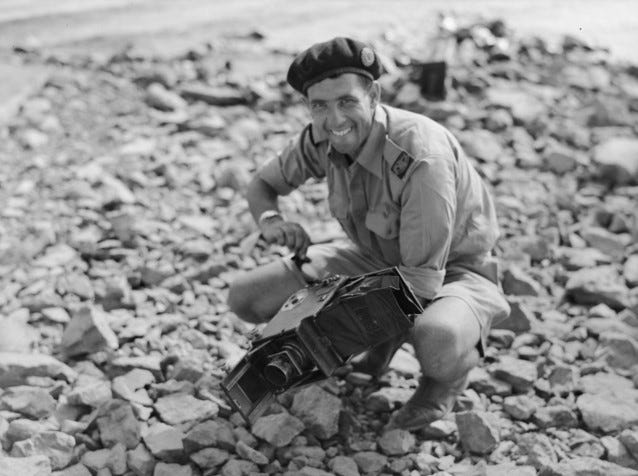Damien Parer, Australia's legendary combat cameraman
Robert Capa famously set the standard for combat photographers with his “if your pictures aren't good enough, you aren't close enough” maxim, an approach that ultimately cost him his life. Damien Parer attacked the job the same way, and met the same fate.
Born Aug. 1, 1912 in Malvern, Australia, just outside Melbourne, Parer fell in love with photography as a boy after joining his school’s camera club. Initially focused on still photography, he began working on movies in his early 20s as a camera assistant to director Charles Chauvel. They would work together regularly through the start of the war.
On Jan. 10, 1940, Parer began work as an official movie photographer for the Australian military and joined the country’s expeditionary force, the AIF, as it sailed for the Middle East. His earliest work involved filming naval engagements and bombardments, but he would begin to do more work on the ground starting in late January 1941 as Australian troops moved into Tobruk.
Days later, he advanced with the infantry in an assault on the aerodrome at Derna, about 100 miles west on the Libyan coast and reportedly decided then that he needed to be as close to the action as possible going forward.
That spring and summer, Parer would film Australian troops in action on Greece and Syria while also returning to document the situation in Tobruk, which would remain under siege through early December, in addition to covering the Western Desert campaign.
While Parer’s footage was widely distributed via newsreel back home, his most notable work would come after he returned to the Pacific theater. In 1942, he joined Australian troops in the jungles of New Guinea, filming the Kanga Force around Salamaua, Lae and Wau. He moved on to cover operations along the Kokoda Track, and his footage from there formed the bulk of an extended newsreel called Kokoda Front Line! released that September.
Parer provided an on-camera introduction to the film, scolding the Australian public for their seeming indifference to the war.
“There seems to be an air of unreality, as though the war were a million miles away,” Parer says. “It’s not. It’s just outside our door now. I’ve seen the war, and I know what your husbands, sweethearts and brothers are going through. If only everybody in Australia could realize that this country is in peril, that the Japanese are a well-equipped and dangerous enemy, we might forget about the trivial things and go ahead with the job of licking them.”
His work, at least, made an impact — and far beyond Australia. In 1943, Kokoda Front Line! won an Academy Award for best documentary short, the first Oscar awarded to an Australian production.
In the interim, Parer kept working. He spent time covering the fighting on Timor late in 1942 before returning to New Guinea to continue documenting the action there in 1943. During this time, he became increasingly dissatisfied with his official role. In August 1943, he left the Department of Information and signed on as a cameraman with the U.S.-based Paramount News.
That move shifted his focus from covering Australian and Commonwealth troops to traveling with the Marines. He landed on Guam with them as they recaptured the island in July and August 1944, then hit the beaches with them the following month at Peleliu.
On Sept. 17, two days after the initial landings, Parer and Sydney Bulletin correspondent John Brennan were accompanying Marines as they advanced across a peninsula behind U.S. tanks. Parer reportedly was walking backward with his camera rolling so he could capture the expressions of the Marines headed toward the enemy when he was cut down by a burst of Japanese machine-gun fire.
“He lay amidst the bodies of the Marines he had gone to photograph,” wrote United Press correspondent Richard W. Johnston.
Tributes from his colleagues universally mentioned his reputation as a man who insisted upon being in the midst of the fighting. Sydney Morning Herald correspondent Guy Harriott would write that Parer probably saw more front-line combat “than any other news photographer in this or any other war.”
“He believed that a war photographer’s place was with the front-line troops, and his utter disregard of danger in carrying out his job made him something of a legend among the AIF and, later, the United States Marines. His complete simplicity and sincerity earned him their affection as well as their respect.”




